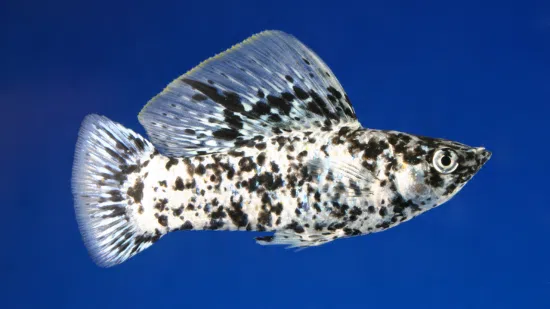Mono Fish
Monodactylus argenteus
(6 Reviews)

Mono Fish
Monodactylus argenteus
(6 Reviews)
{{ item.name }}
Size: {{ item.extra_field_3 }}
${{ getFormattedPrice(item.saleprice) }} ${{ getFormattedPrice(item.price) }}
To join the waiting list, click here
Free Shipping
With
$199.00
or more in Marine Life.
More details...
Mono Fish Care Facts
| Care Level: | Moderate |
|---|---|
| Temperament: | Semi-Aggressive |
| Diet: | Omnivore |
| Reef Safe: | Yes |
| Minimum Tank Size: | 125 Gallons |
| Max Size: | 10 inches |
The Mono Fish, Monodactylus argenteus, also known as the Moon Fish, the Mono, Fingerfish, Silver Moony, and Moonfish, has a distinct diamond shape with a silver body and yellow dorsal fin. They are a great schooling fish, and should be kept in larger groups for the best success rates. They are lively eaters and will eat most prepared foods, carnivorous or herbivorous.
Mono Fish Care Guide
The Mono Fish, scientifically known as Monodactylus argenteus, is a captivating species ideal for saltwater marine aquarium enthusiasts. With its striking appearance and relatively low maintenance requirements, the Mono Fish is popular among hobbyists. It belongs to the Monodactylidae family and is characterized by its sleek, silvery body and distinctive elongated fins. In the wild, Mono Fish are commonly found in estuaries, lagoons, and brackish waters, thriving in environments with moderate salinity.
Habitat and Natural Environment of the Mono Fish
Mono Fish inhabit shallow coastal waters, often congregating near mangroves and rocky shorelines. They prefer areas with gentle water movement and ample hiding spots among aquatic vegetation or rocky crevices. While primarily found in brackish environments, they can adapt well to fully marine conditions with proper acclimation.
Reef Compatibility of the Mono Fish
Mono Fish are considered reef-safe as they do not threaten corals or other sessile invertebrates. However, caution should be exercised when housing them with smaller ornamental shrimp or crustaceans, as they may be considered prey.
Size and Lifespan of the Mono Fish
Juvenile Mono Fish typically measure around 2-3 inches in length, with adults reaching sizes of up to 10 inches or more in captivity. They can live for 5-7 years with proper care, making them a long-term addition to marine aquariums.
Diet of the Mono Fish in Captivity
Mono Fish are omnivorous and readily accept a varied diet in captivity. Their diet should include high-quality flake or pellet food supplemented with frozen or live foods such as brine shrimp, mysis shrimp, and algae sheets. Offering a diverse diet ensures optimal health and coloration.
Aquaculture Availability of the Mono FIsh
While wild-caught specimens were common in the past, Mono Fish are now increasingly available as aquacultured individuals. This sustainable practice reduces pressure on wild populations and ensures healthier, disease-resistant specimens for hobbyists.
Compatibility of the Mono Fish with Tank Mates
Mono Fish are generally peaceful but may exhibit territorial behavior, especially towards conspecifics or similar-looking species. Compatible tank mates include peaceful community fish such as Clownfish, Gobies, Dartfish, Cardinalfish, and peaceful Wrasses. Avoid housing them with aggressive or predatory species to prevent conflict.
Sexual Dimorphism and Coloration Changes in the Mono Fish
Sexual dimorphism in Mono Fish is minimal, making it challenging to distinguish between males and females visually. Juveniles typically display a darker coloration with vertical stripes, gradually fading into the characteristic silvery hue as they mature.
Temperament of the Monofish
Mono Fish are known for their calm demeanor, making them an excellent choice for community aquariums. They may exhibit occasional territorial behavior, particularly during feeding or establishing dominance within a group.
Tank Requirements for the Mono Fish
To ensure the well-being of Mono Fish, a minimum aquarium size of 120 gallons is recommended for a small group. Adequate space allows for natural swimming behavior and reduces aggression among tank mates. Maintain stable water parameters with a pH range of 8.0-8.4, salinity between 1.020-1.025, water temperature of 75-82°F, and moderate water flow.
Why Choose Mono Fish from Saltwaterfish.com?
At Saltwaterfish.com, we pride ourselves on offering the highest quality marine fish, including Mono Fish sourced from reputable aquaculture facilities. Our specimens are carefully selected and quarantined to ensure optimal health and vitality upon arrival. With our commitment to customer satisfaction and sustainable practices, you can trust Saltwaterfish.com to provide exceptional Mono Fish for your saltwater aquarium needs.
The Mono Fish (Monodactylus argenteus) is a captivating species ideal for saltwater marine aquarium enthusiasts. With its striking appearance, peaceful temperament, and relatively low maintenance requirements, the Mono Fish is popular among hobbyists. Following the guidelines outlined in this comprehensive guide, you can successfully incorporate Mono Fish into your marine aquarium setup, creating a vibrant and thriving aquatic environment.
I ordered six of these and they have done amazing. Have grown a lot since I purchased.
Reviewed by: George Straw on Oct. 4, 2025
Love my little schooling fish
Reviewed by: Debbie Cook on Feb. 23, 2025
Reviewed by: Debbie Cook on Dec. 1, 2024
Fish were also small but very active and are eating like crazy.
Reviewed by: James Jameison on Jan. 11, 2024
My Monos just do some light chasing after each other. I bought them the size of nickles...they are 3-4 inches across now. I have four but for my 125, I wish I just had one. They grow really fast and are good at eating pellet foods. You need a big tank for these guys. They are harmless with my other fish and inverts.
Reviewed by: John Atella on June 7, 2022
Love this Mono Fish! He is so beautiful and such an interesting personality! He doesn't bother anyone and has actually become friends with our yellow wrasse! They swim attached at the hip looking for food! He is a very mellow swimmer who loves swimming through the rock work to find new caves. He is a little hard to feed when competing with quicker eaters, I let a couple pellets sink in front of him and sink a few spirulina flakes! I highly recommend him, he is sweet, beautiful, and easy!
Reviewed by: Shia M. on Sept. 12, 2021












